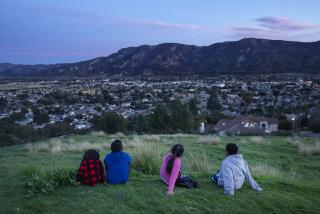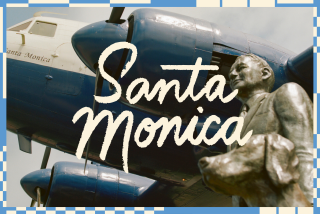Small Town Sights
Santa Paula has only 23,000 residents, but it offers more reasons to mark your calendar these days than most towns its size.
No. 1: The Santa Paula Oil Museum is showcasing a meticulously restored 1960 Austin-Healey Sprite. The puckish sports car, with its trademark bug-eyed headlights, won top honors in international competition for its Thousand Oaks owner.
No. 2: On the first Sunday of each month, Santa Paula lets down its hair and takes people on a nostalgic trolley tour of the city--past historic Victorian homes and along photogenic Main Street, stopping at the train depot to pick up passengers and proceeding to the airport and its collection of vintage planes.
The event is called, not surprisingly, âFirst Sunday in Santa Paula.â The next one, June 1, will be bigger than usual when the town simultaneously hosts its âSample of Santa Paulaâ near the downtown train depot. For $10, you can sample food from 20 local restaurants.
No. 3: The new farmersâ market in Santa Paula is now open on Saturdays from 1 to 4 p.m. next to the depot. In addition to browsing the 20 to 25 vendor booths, you can take a look at two vintage vehicles: a 1900 horse-drawn oil tank wagon and a 1922 oil tanker, both used for local deliveries.
You donât have to wait until June 1 to drop by the museumâs Austin-Healey Sprite exhibit. The museum is open Thursday through Sunday. But the British car, which went on display last weekend, will only be there until June 22. (A summer exhibit, âBrain Teasers,â opens June 1 and features hands-on mind-bending problems to solve.)
As for the Sprite, Rob Garofalo, the carâs owner, began his love affair with the car in 1958 when, fresh out of the Army, he bought one for what turned out to be a two-year odyssey with a pal.
They could have been the inspiration for the TV show âRoute 66,â with its sports car-driving pair of adventurers. âThatâs exactly what we did,â Garofalo said. When they got low on money, they picked up jobs washing dishes or working at carnivals.
That car is long gone, but his fascination with Sprites remains. He bought another and, still later, a beat-up 1960 model. Though not a mechanic, he vowed he would restore it to its original factory condition.
It took him 1 1/2 years of working in his garage, sometimes staying up all night. Guided by manuals, documents from England and photographs he had collected for 25 years, his effort was painstaking.
He managed to find unworn 1960 tires--two in Connecticut, one in New York, and two in California. Through an ad, he located unused 1960 factory-issue floor mats. âIt cost me a fortune, but I had to have them,â he said.
The car has been restored to its original green, although not by Garofalo. Nor did he do the engine and transmission.
âExcept for the battery, itâs 100% factory original--every nut, bolt and washer,â he said. It all paid off in 1992, when he won the prestigious Gold Award at Austin-Healeyâs international restoration competition, the Concourse dâElegance.
Museum visitors can also watch a videotape about the Sprite, which was manufactured from 1958 to 1961 and originally sold for $1,795. Austin-Healey wanted to put out an affordable sports car for college kids in the U.S. that could compete with the popular MG.
And those bug-eyed headlights? They were initially designed to be retractable, but that feature would have cost another $7.50 per car, so the designers left them stationary.
âThatâs what made it such a big hit,â Garofalo said.
If youâre really a sucker for old machines, pencil in âFirst Sunday in Santa Paula.â The trolley (borrowed from Ojai for the day) stops at the museum, where early day oil-drilling equipment is displayed. It pulls up at the train depot to pick up passengers who take the weekend scenic rail trip from Fillmore to Santa Paula, and then it meanders to the airport, where 30 or 40 old aircraft are rolled out for viewing.
The trolley stops on the runway for 10 minutes, but if you want a guided tour of the old planes, you can catch a return trip 30 to 40 minutes later.
The tour is worth it. The world-renowned collection, owned mostly by local pilots, dates to 1930. There are a slew of biplanes and some replicas, like the tiny tandem-winged âFlying Flea,â designed in France in 1934.
The French underground used it as a scout plane during World War II. It escaped detection by the Germans because its wing tips could be folded up, and the plane hidden in a barn.
The tour yields fascinating aviation tidbits. For example, the jaunty long scarf worn by pilots in open-cockpit biplanes was no mere fashion statement, according to docent Anne Bates. It was handy for wiping oil splatters from goggles.
The trolley, which runs from 11 a.m. to 4 p.m. for âFirst Sunday,â isnât really a vintage trolley. But with its bench seats and oak-paneled interior, it feels like one when driver Steve Rouleau clangs the bells as he cruises through town.
Usually on board is a docent who points out landmarks such as the Chili Hut restaurant, where scenes for the movie âLeave It to Beaverâ were shot. The restaurant changed its name for the movie, but an outcry from the local populace got the old name back.
The trolley glides by the Glen Tavern Inn, an early stage stop, and down picturesque Santa Paula Street, with its neat row of Victorian homes, styled after the houses that early residents had left in the Midwest.
âA lot of people have never seen anything like that,â said docent Jim Garfield.
BE THERE
âFirst Sunday in Santa Paula,â offers free trolley tours from 11 a.m.-4 p.m. each month. For information, call (805) 525-5561. The Santa Paula Oil Museum is open Thur.-Sun., 10 a.m.-4 p.m. (805) 933-0076.
More to Read
Sign up for The Wild
Weâll help you find the best places to hike, bike and run, as well as the perfect silent spots for meditation and yoga.
You may occasionally receive promotional content from the Los Angeles Times.






